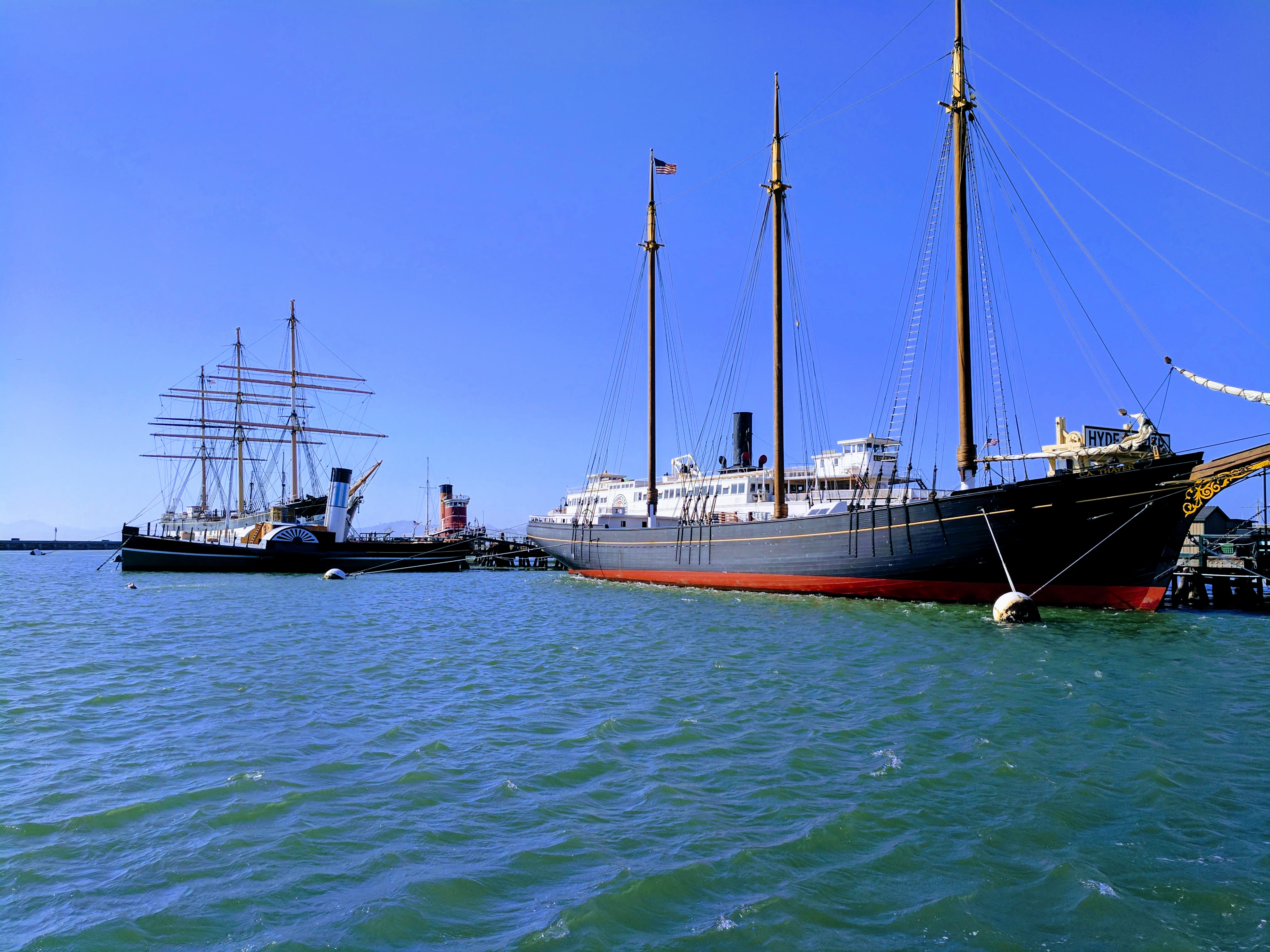Yesterday I swam around Aquatic Park on a sunny, windy afternoon with shreds of fog whipping themselves away from the Golden Gate and across the blue sky.
The wind on the cove gave different textures to water in every part of the cove: Just off the dock and along the buoy line I was swimming into the chop, punching through each wave and gliding just beneath the jade-green roughness of the surface. Alongside the pier, sheltered from the wind, the water took on a darker, smoother quality, with long, easy hills swelling up and down. Beside the opening of the cove, waves rose up to a foot or more in height, and I looked out at the whitecaps in the open bay and decided I didn’t need to be there at all. I swam back through the lively little waves pushed up against the breakwater and what we call the Jacuzzi, a round cement structure at the end of the breakwater, but felt a bit like I was in a foamy, bubbly jacuzzi myself. Around the other side of the breakwater, in its lee, the water was glassy calm, flat, and pale green. Then I swam back out, alongside the sailing ships and encountered bouncy, playful, tumbly waves the color of an overcast sky, which rolled and rocked me back into the dock, laughing and grinning.
Water in the San Francisco Bay is highly changeable, even within the half-mile circle of Aquatic Park, which after all is just a tiny sample jar pulling a bit of water out of an enormous ecosystem. Sometimes the water is murky and brown, sometimes translucently green, sometimes (rarely) completely clear. It can be as salty as the aftertaste of an over-salted salt bagel, or as mild as lake water on the lips.
The Bay is, in a phrase that John McPhee rightly calls haunting, a “drowned river mouth.” Legends of the people who lived here first suggest that the Bay may not have existed at all as recently as a thousand years ago, or maybe a few hundred—the first Spanish explorers apparently sailed right past it without noticing it, which is surprising for explorers in search of good harbors but perhaps not entirely impossible. The underwater topography of the Bay still preserves what was there before: a river canyon, flowing to the sea around a large hill and then between two even higher hills, the sentinels on either side of what we call the Gate. But at some point it sank, or the sea rose, and though the rivers still flow into it their water now mixes early with the inflowing sea tides, swirling around the northern and southern lobes of the bay and creating thousands of microclimates in and around the water.
The water is green because it’s rich with phytoplankton, the tiny algae that convert sunlight and CO2 into oxygen and serve as the foundation of a whole web of life. It’s opaque brown or translucent green-brown because of suspended sediments of silt, brought down from the Sierras along with the snowmelt. Its fish have elevated levels of mercury because mercury was used, 150 years ago, in gold-mining operations in the foothills hundreds of miles away, and the excess mercury ran down into the Bay and sat there for a century, only now starting to diminish in its effects as the silt covers it up. Because of the mercury you shouldn’t eat certain fish more than once a month, although some of the fishermen along the pier, who are fishing for their dinners, for their families, probably eat more than that. It’s saline because of the ocean and fresh because of the rivers. It’s cold, and the more ocean water pours in the mouth of the Gate the colder it gets, but in the southern and northern, shallower parts of the Bay, the water warms up to bathlike temperatures.
And its currents are maddeningly complex. Tides alone have their own rhythmic predictability, so as mysterious as they may seem while you’re standing on the beach, they’re orderly and rational enough that a simple algorithm in an app can calculate the high and low tides at any time of day anyplace in the world. But the inward flood of water leading to the high tide, and the outward ebb on the way to low tide, are truly hard to grasp. Fluid dynamics at large scales are not easy to understand intuitively, the rivers add another complication, and the involuted, lobed shape of the Bay makes everything cockeyed.
Everyone who swims at Aquatic Park has their own rule of thumb for guessing the currents. Some who have guessed badly, or are not prepared for the currents, have been trapped, terrifyingly, against the pier, pinned down by a current they couldn’t fight. My principle is to listen to people, watch the water, and make my own decisions. I pay close attention to what the water’s doing, how it feels, how it tastes, whether there’s a seam between a patch of ruffled water and a patch of smooth. I watch the shoreline to see how I’m drifting, and time myself between landmarks I know to see if the current is speeding me up or slowing me down. I don’t go outside the cove alone. But those are my rules, and I only know a little about the Bay. I’ve only been swimming here a few years. I still have much to learn.
Note: I’m planning on doing a 6.5-mile (10km) swim in the Bay on July 9, for Baykeeper’s Bay Parade. Would you support my swim for a cleaner Bay?
And if you’d like to follow along with my adventures, please enter your email address here and I’ll keep you posted:
[xyz-ihs snippet=”swimform”]

